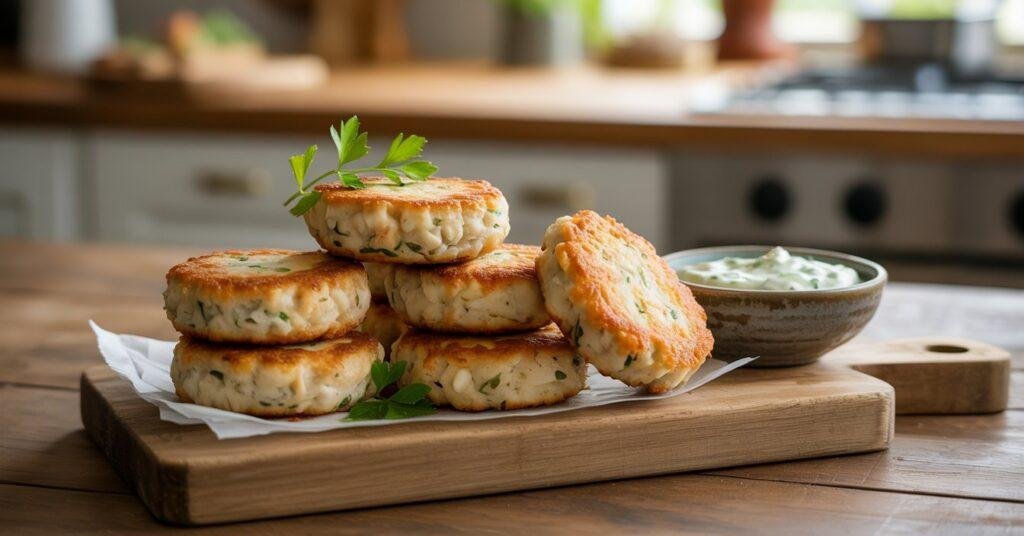The Best Fluffy Pancakes recipe you will fall in love with. Full of tips and tricks to help you make the best pancakes.

Have you ever wondered how to cook frozen fish cakes perfectly crispy every time? Whether you’re a beginner in the kitchen or a professional home cook, reaching that perfect golden-brown crust on your fish cakes can occasionally feel like a challenge. But worry no more! This straightforward guide will take you step-by-step through the best way to cook frozen fish cakes, including tips for pan-frying, air-frying, and even boiling them to perfection. Discover quick dinner ideas, learn healthy seafood recipes, and master the art of making crispy fish cakes at home every single time.
Why is mastering frozen fish cakes cooking critical?
Frozen fish cakes are a suitable and tasty dinner choice that can be prepared in minutes, but cooking them perfectly can make a significant difference in taste and consistency. From the ideal crispy crust to the tender fish inside, finding the art of cooking frozen fish cakes confirms that every bite is enjoyable. This guide is prepared for everyone – from newbies in the kitchen to skilled cooks looking to perfect their frozen fish patties. So, let’s dip right in and discuss how to cook these delicious treats completely crispy every time!

Understanding Frozen Fish Cakes
What are frozen fish cakes?
Frozen fish cakes are pre-cooked patties made primarily from fish, breadcrumbs, and various seasonings. These patties are typically frozen to preserve freshness and make cooking quick and easy.
Ingredients typically used in frozen fish cakes.
Frozen fish cakes can be made with a variety of ingredients, but the base usually includes fish (like cod, white fish, raw fish, scoop fish, salmon, or haddock), king fish, breadcrumbs, potatoes, waxy pototoes, green onions, herbs, and spices. Some versions may also include a bit of egg or flour to help bind the ingredients together.
Varieties available in the market
This frozen cakes come in many varieties. Some are made from a single type of fish, while others may include a blend of seafood like shrimp and scallops. You can also find different flavor profiles, from classic British fish cakes to spiced versions with curry powder or chili.
Preparation Before Cooking
Do you need to thaw frozen fish cakes?
The answer turns on the cooking process you choose. Most methods, like pan-frying or baking, can be done without thawing. However, if you’re using a deep fryer, it’s usually best to thaw them to ensure even cooking and avoid oil splattering.

Reading the label: cooking instructions, ingredients, and allergens
Before cooking, still check the label for essential cooking instructions, ingredients, and allergen Information. Multiple fish patties have gluten or shellfish, so it’s critical to confirm they suit your dietary needs.
Basic tools and spoons
To cook frozen fish cakes, you’ll need basic kitchen tools such as a non-stick pan for frying, a baking tray for the oven, or an air fryer basket. Make sure to have a thermometer on hand to check the internal temperature and a spatula to flip the cakes without breaking them.
Fish cake recipes
There are several ways to cook frozen fish cakes, each offering its unique benefits. Let’s look at the most common methods.
Pan-Frying
Step-by-step pan-frying process
Pan-frying frozen fish cakes is a quick and easy method to get that crispy exterior. Warm a short quantity of oil in a pan over medium heat, and once the oil is burning, add the frozen fish cakes to the pan. Cook for about 4-5 minutes on each side or until golden brown and crispy.
Tips for achieving a golden crust
To achieve a golden crust, don’t overcrowd the pan. That will allow the fish cakes to crisp up evenly. Additionally, use a high-quality oil, such as vegetable oil, which has a higher smoke point.
Pros and cons
Pan-frying is quick and gives the fish cakes a crispy texture, but it does require constant attention to avoid burning. It’s also not the healthiest option since it involves using oil.
Baking in the Oven
Temperature and timing guide
Baking frozen fish patties in the oven is a more beneficial option as it uses less oil. Preheat the cookstove to 400°F (200°C). Position the fish cakes on a baking tray lined with parchment paper and bake for about 10-15 minutes, turning them midway.
Using parchment paper or foil
Parchment paper or foil helps prevent the fish cakes from sticking to the tray and ensures an even cook. It also makes cleanup easier.
When and how to flip them
Flipping is vital for an even cook. After about 10 minutes, gently flip the fish cakes to ensure both sides are crispy.
Air Fryer Cooking
Preheating and positioning
The air fryer is an excellent tool for achieving a crispy texture with less oil. Before heating your air fryer to 375°F (190°C). Position the icy fish cakes in a single layer in the basket, ensuring they are not overlapping.
Advantages for health and texture
Air frying is healthier than traditional frying as it uses little to no oil. The texture is often just as crispy, with less fat, making it a great alternative.
Best air fryer settings for fish cakes
Cook these 10-15 minutes, turning them over to ensure both sides get golden brown and crispy.
Deep Frying
Oil selection and temperature control
For serious frying, use oil with a high smoke point, such as vegetable or canola oil. Warm the oil to about 350°F (175°C). Carefully lower into the oil, one by one, using a slotted spoon.
Safety precautions
Baritone frying can be risky if not accomplished carefully. Always use a thermometer to ensure the oil temperature is correct, and never leave the fryer unattended.
Ensuring a non-greasy finish
To avoid greasy fish cakes, drain the cooked cakes on paper towels right after frying.
Microwave Cooking
When to use this method
Microwave cooking is the fastest method, but doesn’t result in the best texture. Use this method if you’re short on time and don’t mind a less crispy exterior.
Texture expectations
It will be soft and slightly rubbery, lacking the crispy texture achieved through frying or baking.
Microwave-safe dishes to use
Use microwave-safe plates and cover the fish cakes with a microwave-safe cover or a kitchen paper towel to ensure they cook evenly.
Grilling and Barbecuing
Outdoor or stovetop grilling techniques
Grilling adds a unique flavor to the fish cakes, especially when using charcoal. Before heating the grill to medium-high, boil the frozen fish cakes for 3-5 minutes on each side.
Flavor tips (smoke, marinades)
Add extra flavor by marinating the fish cakes in a simple mixture of olive oil, green onions, lemon, and herbs before grilling. You can also experiment with a smoky barbecue sauce.
Avoiding dryness
To prevent these cakes from drying out, keep a close eye on them and gently flip them.

Internal Doneness and Safety
How to check the internal temperature
The internal temperature of the cakes should reach 165°F (74°C) to ensure they are fully cooked and safe to eat.
Visual and textural indicators
Separated from using a thermometer, you can review doneness by cutting one open. The fish should be clear and flake smoothly with a knife.
Food security criteria
Constantly confirm that you cook frozen fish cakes to the suggested temperature to prevent foodborne illnesses.
Flavor Enhancements
Marinades and seasoning blends
To elevate the flavor, try marinating these cakes before cooking. A combination of lemon juice, garlic, green onion, and flavorings can add a fresh taste to the fish.
Using sauces before or after cooking
Fish cakes pair wonderfully with a combination of sauces. Try tartar sauce, aioli, or even a spicy sriracha mayo to add more flavor.
Incorporating herbs, spices, and citrus
Don’t be afraid to experiment with spices like paprika, dill, or parsley. A squeeze of lemon just before serving adds a blast of freshness.
Dipping Sauces and Toppings
Classic sauces: tartar, aioli, sweet chili
These are traditional choices that complement the crispy fish cakes. Tartar sauce adds a sour cream, tangy element, while sweet chili provides a mild heat.
DIY sauce recipes
To make a simple aioli, mix mayonnaise with minced garlic, lemon juice, green onion, and olive oil. For a sweet chili sauce, combine honey, black pepper, chili flakes, and vinegar.
Garnishing for texture and flavor
Try topping your cakes with new seasonings like cilantro or parsley for an added pop of color and taste.

Mistakes to Avoid
Common cooking errors
One of the most common mistakes is overcooking or undercooking the fish cakes. Keep an eye on them to ensure they don’t burn or remain raw in the center.
Overcooking vs. undercooking
Overcooked fish cakes will be dry, while undercooked ones will be mushy inside. Always aim for a crispy exterior and a tender, flaky interior.
Handling frozen patties improperly
Never thaw frozen fish cakes in the microwave, as this can cause them to become soggy and lose their texture. Always cook them directly from frozen unless specified otherwise.
Health and Nutrition
Are frozen fish cakes healthy?
Frozen fish cakes can be a healthy meal option when made with high-quality fish and minimal added ingredients. They provide a good source of protein and omega-3 fatty acids.
Nutritional values to consider
Check the label for Information on calories, fat content, and sodium. Opt for options with lower sodium content for a healthier choice.
Healthier cooking options
Baking or air frying frozen fish cakes is the healthiest cooking method, as it uses less oil, making them lower in fat compared to deep-frying.
Storage and Leftovers
How to store cooked fish cakes
Store any leftover cooked fish cakes in an airtight container in the refrigerator. They should be eaten within 2-3 days for the best quality.
Reheating methods that retain texture
Reheat fish cakes in the oven or air fryer to maintain their crispy consistency. Bypass microwaving if you enjoy keeping the crispiness.
Freezing leftovers safely
If you have leftovers, freeze them in a single layer before placing them in a freezer bag. That will help prevent them from sticking together.
Choosing the Right Frozen Fish Cakes
How to read packaging and components
When choosing frozen fish cakes, read the packaging carefully to confirm you understand the ingredients and the nutritional Information. Look for options with the tiniest additives and preservatives for a healthier option.
Recommended brands (optional list)
Some trusted brands for frozen fish cakes include Gorton’s, Birds Eye, and Iceland. These labels offer a combination of tastes and techniques.
Budget vs. premium options
Budget options are perfect for daily feeds, while premium choices often feature higher-quality fish and more delicious seasoning mixes.
Summary
In conclusion, cooking frozen fish cakes can be easy and rewarding with the correct technique. Whether you pan-fry, bake, or air fry, there’s a method for everyone to enjoy perfectly crispy fish cakes every time. Remember to experiment with different cooking techniques, herbs, and spices to maximize the flavor of these delicious seafood options.
Frequently Asked Questions (FAQs)
How do you cook frozen fish cakes?
You can pan-fry, bake, air-fry, or deep-fry frozen fish cakes. Pan-fry for 4-5 minutes per side, bake at 400°F for 15-20 minutes, air-fry at 380°F for 10-12 minutes, or deep-fry at 350°F for a crispy finish. Constantly review the inner temperature (165°F/74°C).
How do you cook frozen fish patties?
Frozen fish patties can be cooked the same way as fish cakes. Pan-fry, bake, or air fry them for a crispy texture. For pan-frying, cook for 4-5 minutes on each side.
What is the best way to cook fish cakes?
The best method depends on preference. Pan-frying gives the crispiest texture while baking and air frying are healthier options. Pan-frying is typically preferred for the best combination of crispiness and flavor.
Can I eat fish cake without cooking?
It’s not recommended. Although fish cakes are pre-cooked, they must be reheated to ensure they are safe to eat and have the proper texture. Always follow cooking instructions for safety and taste.




